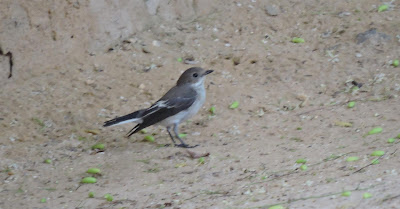I will go to these places in good time though transport will be an issue. However I am not a visiting birder. I have started work here and will bird in any spare time I have.
At the moment I am based in central Nouakchott in the leafy district of Taveragh Zeina.
In the first two days, I have restricted myself to walking round the neighbourhood in the early morning. It is seriously hot during the day.
Iberian pied flycatcher 1
It is almost immediately obvious that the bushes and trees are teeming with early migrants from western Europe. I believe this should not be a surprise because Nouakchott is the first greenery south of the Sahara and very close to the Atlantic coast.
Pied flycatcher is relatively common. The one in the first two pictures is of the Iberian sub-species. The tail is all black ruling out nominate but the lack of a very large white patch and lack of the strong second white wing bar rules out Atlas flycatcher (sub species as far as e-bird is concerned). This bird is an Iberian pied flycatcher.
Iberian pied flycatcher 2
The bird below is of the nominate sub species. Please note the white edges to the tail.
nominate pied flycatcher
Remarkably spotted flycatcher is less common at least at the moment.
spotted flycatcher
For me, the main story of this birding so far is the volume of warblers in the trees and bushes.
first year willow warbler
The most numerous warbler at the moment is willow warbler. While western olivaceous warbler is the second.
under the first year willow warbler
I have also seen two western Bonnelli's warbler.
first western Bonnelli's warbler
All doubts of the birds nature were dispelled when it flew. The yellow rump magnifies the yellow-green in the wings and makes it distinctive.
second western bonnelli's warbler
I have also seen singles of lesser whitethroat, Eurasian reed warbler and chiffchaff so far.
I am working off the first edition of Birds of Western Africa and the Atlas of Mauritanian birds. The blue-cheeked bee-eater I am seeing are most likely resident birds.
The guide book shows them resident just south of Nouakchott but I suspect these birds are too.
blue-cheeked bee-eater flying off
a settled blue-cheeked bee-eater
Another resident bird is blue-napped mousebird. Nouakchott is at the extreme north of it breeding range.
blue-napped mousebird
Interestingly, the first editon of Birds of Western Africa doesn't have an entry for European collared dove yet the book covers Nouakchott. Conversely the Atlas of Mauritanian birds has no records of African collared dove.
European collared dove
Both sources only show half the picture. The city contains both. European collared dove is the more common.
One way of separating them is the colour of the lower belly and vent. It is almost white in African collared dove and grey in European collared dove.
Underside of European collared dove
African collared dove was more difficult to find though I heard it twice before seeing one.
African collared dove
Other doves observed so far are: laughing dove, feral pigeon (rock dove) and Namaqua dove.
Namaqua dove
There are probably hundreds if not thousands of house sparrow in the city but the e-bird database is querying my records of above 20 each walk. I think this is symptomatic of the recent expansion of this species into sub-saharan Africa.
house sparrow
Another invasive species is rose-ringed parakeet and they were soon found.
More blogs will follow as I am here for the duration. It has been an interesting start.

















I know nothing about Mauritania so I look forward to reading your blogs from there so I can learn about the place. I hope you get lots of good birds.
ReplyDeleteThanks John. I am sure there are good birds here. The biggest problem is transport. Once I can find a way to get around more easily then I expect some really good results.
DeleteGreat Start Rob, amazing how many similarities there are to here. Looking forward to the new list. B
ReplyDeleteBernard, Thanks for this. Nouakchott and further north are most similar to our birding in Saudi Arabia. However further south is quite different! I like the mix. Rob
ReplyDeleteThis comment has been removed by the author.
ReplyDelete